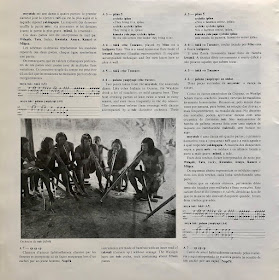The Great Tradition – Masters of Music – His Master's Voice – EALP 1453/1452, Compilation 1986, Part 1 Hindustani Music curated by Sheila Dhar (2 LP)
This
double LP, published in 1986 for the Festival of India, is a unique panorama of
Indian traditional music, showcasing a gorgeous selection of some of the major
20th-century artists in both the Hindustani and Carnatic traditions.
In
this post we present the Hindustani music expertly curated by the writer and Kirana
Gharana vocalist Sheila Dhar (1929-2001). Note that out of the 14 tracks she selected
only three are instrumental, emphasizing the central role of vocal music in the
North Indian idiom. Instrumentalists themselves are often much influenced by vocal
music. The great sitar player Vilayat Khan (C2), for example, once said "…there
are four great singers who have influenced me… Faiyaz Khan [A4] was royal and
regal and dignified. Abdul Karim Khan [A3] represented beauty. Bade Ghulam Ali
Khan [B1] was about freedom… and Amir Khan [B4] is only about ibadat. Prayer."*
*https://thebookreviewindia.org/life-and-music-of-ustad-vilayat-khan/
Ce double album, publié en 1986 dans le cadre du Festival of
India, offre un panorama exceptionnel de la musique traditionnelle indienne, avec
une superbe sélection de certains des plus grands artistes du XXe siècle dans
les traditions Hindustani et Carnatic.
Dans ce post, nous présentons la musique de l'Inde du nord sélectionnée ici par l'écrivaine et chanteuse du Kirana Gharana, Sheila Dhar (1929-2001). Veuillez noter que sur les 14 pistes choisies, seules trois sont
instrumentales, soulignant bien le rôle central joué par la musique vocale dans la
musique Hindustani. Les instrumentistes eux-mêmes sont souvent grandement influencés par la musique vocale. Le grand sitariste Vilayat Khan (C2), par exemple, déclara : "… quatre grands chanteurs m'ont influencé ... Faiyaz
Khan [A4] pour sa musique impériale, empreinte de noblesse et de dignité. Abdul Karim
Khan [A3] qui incarnait la beauté même. Bade Ghulam Ali Khan [B1] qui inspirait
la liberté… et la musique d'Amir Khan [B4] qui n'était que l’ibadat, la prière."*
A1
– Zohra Bai, or Zohrabai, (1868-1913), vocalist of the Agra Gharana.
A2
– Bundu Khan, or Bundoo Khan, (1880-1955), sarangi player of the Delhi Gharana from
Karachi, Pakistan.
A3
– Abdul Karim Khan (1872-1937), vocalist founder of the Kirana Gharana.
A4
– Faiyaz Khan (1880-1950), vocalist of the Agra Gharana.
A5
– Kesar Bai Kerkar (1892-1977), vocalist of the Jaipur-Atrauli Gharana.
A6
– Krishnarao Shankar Pandit (1894–1989), vocalist of the Gwalior Gharana.
B1 – Bade Ghulam Ali Khan (1902-1968), vocalist of the Patiala Gharana.
B2
– Siddheshwari Devi (1908-1977), vocalist of the Banaras Gharana.
B3
– Mallikarjun Mansur (1910-1992), vocalist of the Jaipur-Atrauli Gharana.
B4
– Amir Khan (1912-1974), vocalist founder of the Indore Gharana.
B5
– Gangubai Hangal (1913-2009), vocalist of the Kirana Gharana.
C1
– Ravi Shankar (1920-2012) and Ali Akbar Khan (1922-2009), sitar and sarod players
of the Maihar Gharana.
C2
– Vilayat Khan (1928-2004), sitar player of the Imdadkhani Gharana.
C3 – Kishori Amonkar (1932-2017), vocalist of the Jaipur-Atrauli Gharana.
***
I
dedicate this post to the memory of our great blogger friend Tawfiq (http://oriental-traditional-music.blogspot.com) who passed away in April. Tawfiq's superb blog enriched the lives of music
lovers around the world and, on a personal level, inspired me to start my own
blog. With over 650 LPs and cassettes shared since 2011, his work is truly
monumental, and we all hope arrangements have been made to ensure his many rare
treasures of Hindustani, Carnatic, Pakistani, Iranian, Turkish, Syrian, Iraqi,
Azeri, Moroccan, Islamic, and other musics will continue to be available online
for years to come. Music was his raison
d'être and he shared meaningful, timeless tracks with us until his last
breath. May his spirit soar on the imperishable music he loved.
***
Photographs below are from Music on Record by Frederick William Gaisberg, published by R. Hale,
1947, Musiques Rituelles, Cahiers de Musiques Traditionnelles 5, 1992, and Tantra Asana, A Way to
Self-Realization by Ajit Mookerjee, published by Ravi Kumar, 1971:
Zohrabai Agrewali
c. 1908 [A1]
Baba Allauddin Khan (1862-1972), center, with some of his first students, c. 1925. One of the greatest teachers and musical minds of the 20th century whose illustrious disciples included his son Ali Akbar Khan and Ravi Shankar [C1], Pannalal Ghosh (1911-1960) and Nikhil Banerjee (1931-1986).
Bhairava painting, Deccani School. c. 18th century.
"A
Tantric Yogi, dark-skinned, red eyed, squatting on a white asana, is listening
to a raga, most probably Bhairava, since Raga Bhairava's family colour for distance
is usually olive green and sky area bluish grey, traversed by several currents
of wavy greyish white clouds. Siva's archetype is generally found in the
traditional representation of tantric Bhairava which is shown as naked, with
dishevelled or matted hair, ash besmeared, wearing rudraksha garland and pendant snake earrings (kundala) and sitting on a tiger skin under a tree – absorbed in
profound meditation."



































